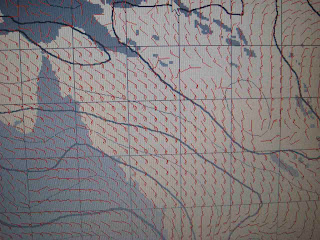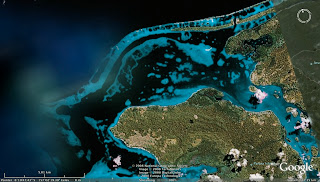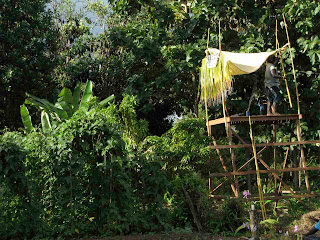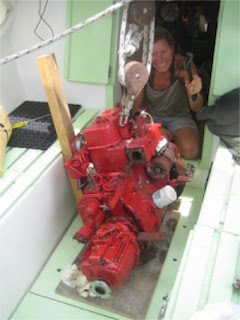
The High Pressure system that blew the KUNA half way through the Solomon Sea (April16th GRIB)

Gilbertes live on this island opposite Gizo,view from the KUNA at anchor

Gizo harbour, finally in another country

First sight of land after a squall

Tuna fishing boat: encoutered a couple, no more

Becalmed in the middle of the solomons sea, Half way through PNG and Gizo

Fully reefed main and staysail to for beating in 25 knots SE winds

Windvane and sunset in the coral sea

Trackt to Solomons
Townsville to Gizo: a sailing passage through the Coral Sea and the Solomon Sea
If the pics haven't made it, they will come soon!
It didn't look that easy but after a close look at the charts the course turned out to be achievable for the KUNA in moderate South East trades winds: a course of 42¼T to Rossel Island (Eastern most trip of PNG) and then a turn to 35¼T to Gizo, avoiding famous Pocklington Reef (famous for its wreckages)
Day 1 April 12th 2008
The Kuna exited Townsville on motor, just another couple hours running it to double check that it was OK. It was an opportunity to get upwind of the course through the Magnetic passage. Threading the Magnetic passage is a good way out of the Great Barrier Reef as few ships use it and the reefs are sparse and current is not as an issue as in the Hydrograpers. Kuna was out in the open water that night, great feeling!
Day 2 April 13th 2008
Beating in light winds, Dart Reef, small reef west of Flinders Reefs was rounded at about 1300 the next day. With the SE winds becoming stronger, maintaining a bearing of 65¼T (higher than course) to round Willis Island from the South became impossible and, after passing to the NW of Herald Kays, Kuna had to bear off to 42¼T.
Day 3 April 14th 2008
In the morning, Kuna threaded her way in the deep water between the back of the Willis Island rise and the rise further West. At 9AM, whilst 16Miles from Willis Island, a weather forecast was requested by VHF (they listen on Ch 16) from the Meteorological Observation station. The guys were courtous enough to check the forecast with Brisbane (they are only an observing station) and invited us for a cuppa. No time to stop though. They were expecting an ex ANARE observer, wondered if we knew him!!!
A couple of hours later, Kuna is out in the open (yaaaay, no more reefs to dodge!) and set on a course of 42¼T, or anything possibly higher to try and make as much easting as possible in case the strengthening winds did turn Easterly with the High Pressure system coming across. From the forecast, the winds were predicted to strengthened to 25-30 the next day and a 1.5 was already roaming on top of a 2m swell. Fully reefed main and 1/3 jib.
Another birthday at sea, though not on the Aurora Australis, this time (bugger, I'm sober!!)
Day 4 April 15th
Beating with a fully reefed main and staysail, Kuna climbed comfortably the 4m waves in 35 knots of wind maintaining a good 6knots. 20-30 degrees higher than course, preventing an uncomfortable roll. I downloaded a weather grib files and know why we are getting such strong winds now: the GFS model indicates that HIGH has gone huge, spreading over most of North Queensland. Hopefully it will last and is push the Kuna in the right direction at high speed (well, 10 T of boat travelling at 6 knots with fully reefed main and staysail feels fast enough). Speed record surfing down a wave was 12.1 today.
Day 5 April 16th
More of the same, strong winds, climbing huge waves, starting getting into the swing of watches well, though 3 four hours watches is a busy schedule. Lucky the wind vane is working well most of the time. Only when KUNA rounds up heavily it needs to be helped by locking the rudder slightly to leeward (to get her back downwind). When the winds get really overpowering, time to stir by manually but it only occurred twice so far, luckily because she is heavy.
Day 6 April 17th
That morning, approaching Adele Island and Rossel Island, the Eastern Most tip of PNG. Passing it 20 miles away to avoid overfalls. Large swells (5m ish) have travelled from further South and there is still up to 20 knots of wind to help the Kuna run (35T). The question is how far will those winds push her until she hits the Doldrums. Turning the corner and entering a new sea, the Solomon Sea, is not without noticeable effect: in between surfing down the huge southerly swells (speed record 14.3 today!), the Kuna rolls under the influence of North Westerly swells, from a system a long way away, north the of the equator even maybe. With 20 knots of wind on the top it makes the sea pretty irregularly rough. The pressure keeps dropping regularly: we are about to cross a trough of low pressure in a few hours. Squalls are building up on the horizon. Electric storms are also brewing, it is a threatening feeling to be the only tall steel structure for 100s of miles!
Day 7 April 18th
Later that night (midnight watch), bucketing rain which barely could let me see the wind arrow on the top of the mast hits the KUNA and she screameds down the swells at 10 knots under full main. Needless to say a bit of rudder is needed to help the windvane and prevent her from rounding up. Then an hour of so later, the wind dies completely, leaving the KUNA bobbing around on an incredibly shockingly rough sea. As learned the hard way, it is very damaging for the sails to bash again the rigging hoping to get some wind: the fully battened main developed chafe along the batten pocket at every point of impact and the preexisting reinforcing patches have to be beefed up. On the chafe front, I discovered pulling the full main that the lazy jacks also had some damage to the reefed belly in the last 5 days of beating. One more patch to plan on. Yellow fin Tuna for dinner, the one and only fish caught on the trip!
Day 8 April 19th
Stopping the motor after a long night to have a swim around the boat and breaky in silence. 50 miles covered in the last 24 hours, mostly motoring. A few attempts of catching the wind today, one with the MPS which seems to reach very well but that course would have taken the Kuna to Bougainville so back to motoring, which makes the hours slow... The tachometer is still not calibrated properly (how many pulses does a BOSCH 24V alternator send per revolution?) so the rpms of the new motor are estimated according to speed performance. About 4.5 knots, 28¼T Slow. At the end of the day comes a squall, lots of rain (= a great shower!!) and some winds, which bring us 5 mils further! Second tuna fishing boat sighted, quite flash boat. Later that evening the double hill shape of Simbo island clears out of the clouds.
Day 9 Arrived!!! April 20th
Slept until 1AM in completetely still seas, waiting was necessary to make the landfall the nest morning by motor, yes, another 22 miles of motoring in beautiful dead calm seas to Gizo harbour. T took 28 hours of motoring on and off to go through 170 miles in the doldrums. The approaches were amazing, tight passage (well not so tight) through a couple of reefs, only visible due to a little break in flat calm weather and morning light. Anchored in front of the Mobil station in 12 m of mud. Tight anchorage (100 m from town!) with light onshore winds. Sunday morning, church sounds and silhouetted canoes travelling from island to island surround the Kuna.
Post passage maintenance list for today (small):
- Some chafe from lazy jack and rig onto the fully battened main: reinforce protective patches to prevent
- Equip lazy jack with soft transparent plastic pipe to prevent chafe (they are useful to contained the large area reefed sail) and equip spreaders with anti chafe gear (gaffa tape some soft material on them)
- Protective plank under the anchor to avoid head bashing against the deck (and scraping paint)
- Set up boat for deep anchoring: make the 110 m of 10 mm chain readily available (Its not Queensland shallows anymore!) and place swivel on main anchor to enable for frequent wind shifts at anchor without twisting the chain
- Engine 25 hours routine maintenance (oil and oil filter change, need to look after the new BUkh well!
- Fix a small leak in the manual bilge pump: quantities of oil lost by the old motor must have had reason of one valve
- Fix one and only small leak in aft hatch: pleasant surprise in this testing weather with lots of greenies over the bow)
All jobs seemed so easy after a week of trying to do stuff in a rolling boat!
Rest. Clearing and Shoot starting tomorrow










































